FNN 6800 Assignment: Environmental Cost Accounting and Decision Making
VerifiedAdded on 2023/01/05
|12
|3729
|56
Report
AI Summary
This report delves into the critical issues businesses face in managing environmental costs, exploring various accounting methods used to address these challenges. The first part analyzes environmental management accounting, highlighting the significance of environmental costs, internal and external factors, and the need for integrated accounting activities. It emphasizes the importance of environmental planning, preventing damage, and the role of Environmental Management Accounting (EMA) in decision-making. The second part focuses on decision-making processes, emphasizing the role of management accountants in providing crucial information for improved performance. The report examines how businesses incorporate management accounting planning, utilizing tools like cost accounting and financial analysis to achieve sustainable financial results. The report also discusses how the implementation of key performance indicators (KPIs) and strategic planning can help businesses to improve their financial performance. It concludes with a discussion of the importance of financial officers in making internal decisions that contribute to success and growth. The report uses Waitrose as a case study to illustrate these concepts. The assignment covers issues faced by businesses in managing environmental costs and the different methods used in accounting for these costs and how management accountants can use the right tools to provide the right information about how to improve performance and understand the implications of Key performance indicators.

Financial Performance Management
Paraphrase This Document
Need a fresh take? Get an instant paraphrase of this document with our AI Paraphraser
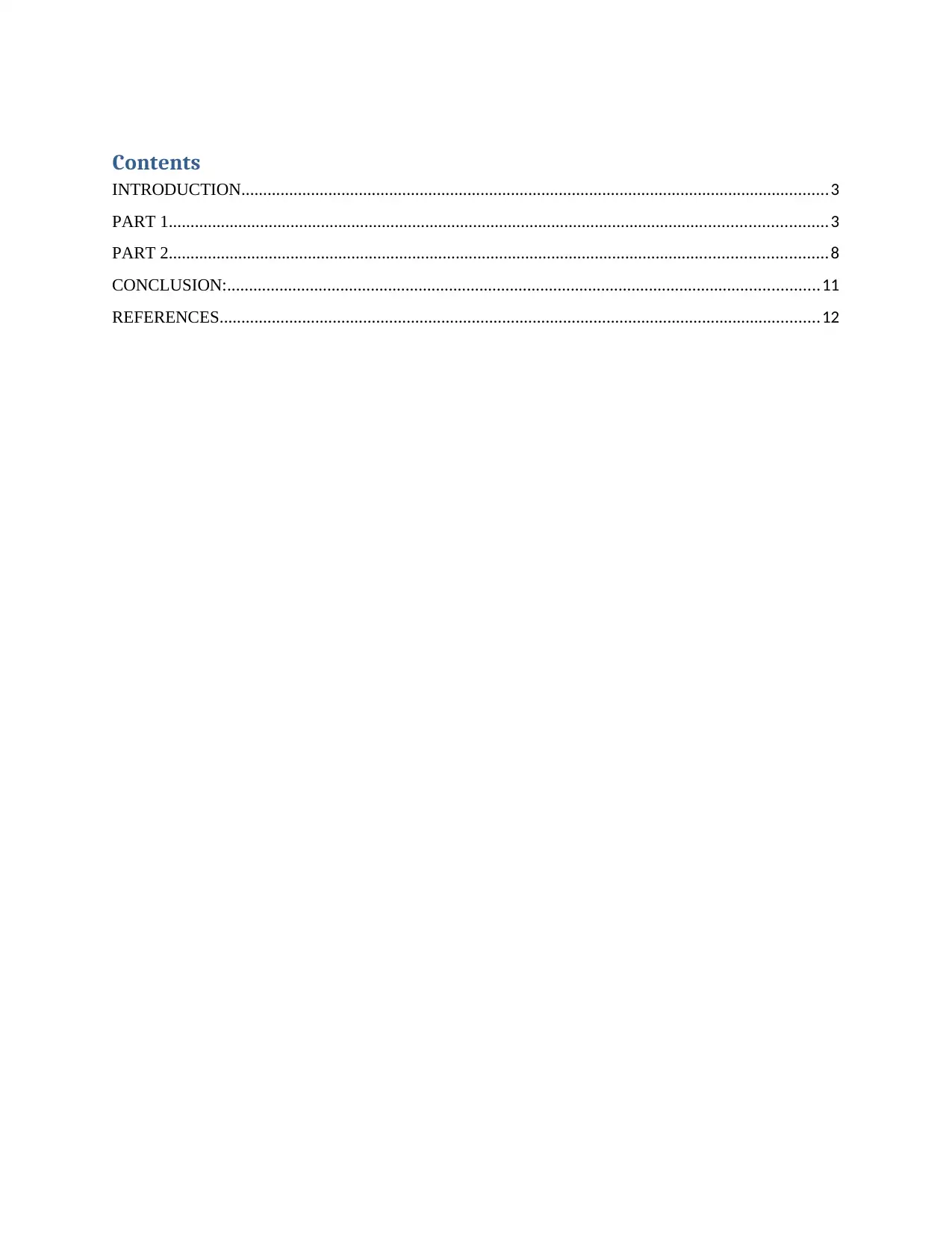
Contents
INTRODUCTION.......................................................................................................................................3
PART 1.......................................................................................................................................................3
PART 2.......................................................................................................................................................8
CONCLUSION:........................................................................................................................................11
REFERENCES..........................................................................................................................................12
INTRODUCTION.......................................................................................................................................3
PART 1.......................................................................................................................................................3
PART 2.......................................................................................................................................................8
CONCLUSION:........................................................................................................................................11
REFERENCES..........................................................................................................................................12
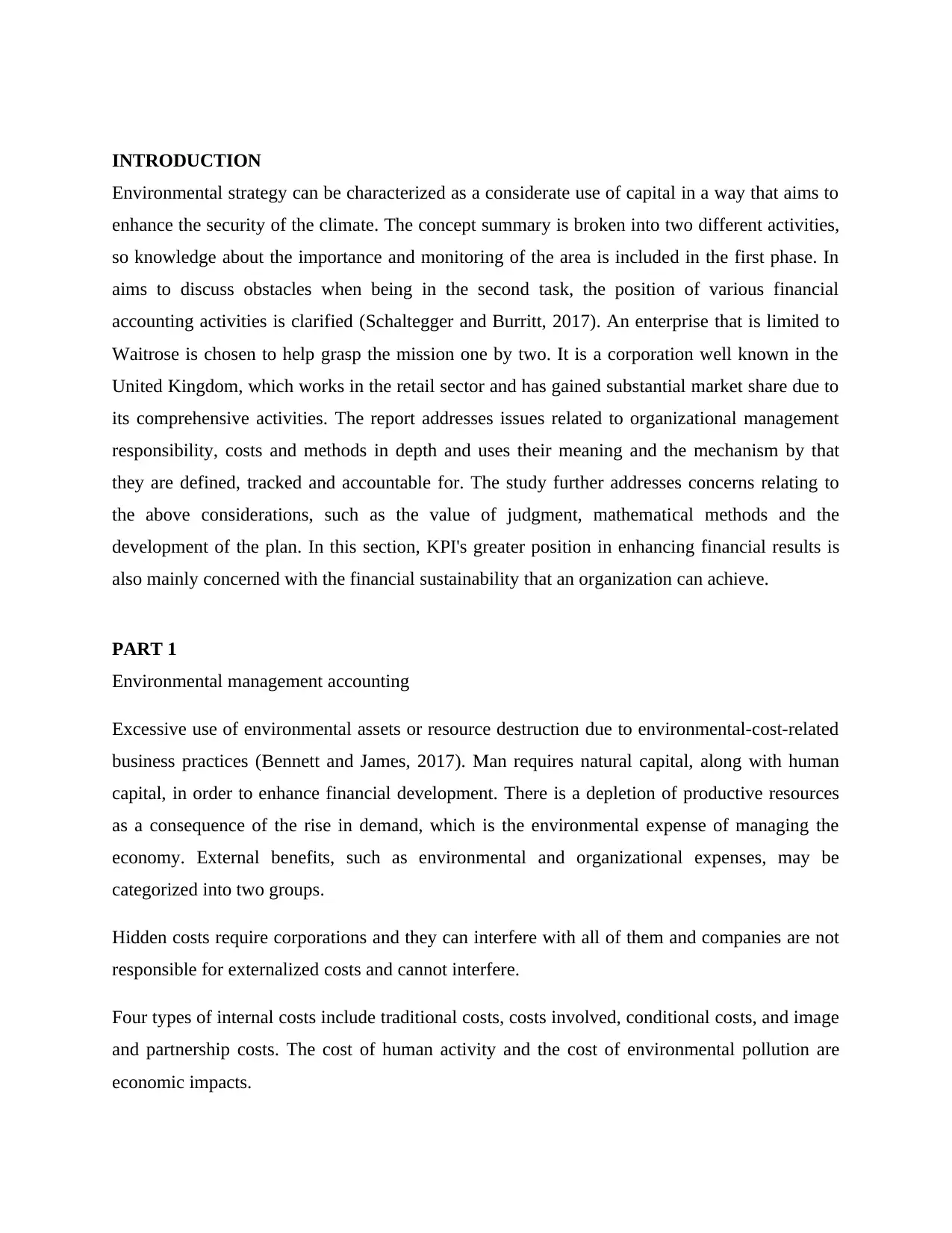
INTRODUCTION
Environmental strategy can be characterized as a considerate use of capital in a way that aims to
enhance the security of the climate. The concept summary is broken into two different activities,
so knowledge about the importance and monitoring of the area is included in the first phase. In
aims to discuss obstacles when being in the second task, the position of various financial
accounting activities is clarified (Schaltegger and Burritt, 2017). An enterprise that is limited to
Waitrose is chosen to help grasp the mission one by two. It is a corporation well known in the
United Kingdom, which works in the retail sector and has gained substantial market share due to
its comprehensive activities. The report addresses issues related to organizational management
responsibility, costs and methods in depth and uses their meaning and the mechanism by that
they are defined, tracked and accountable for. The study further addresses concerns relating to
the above considerations, such as the value of judgment, mathematical methods and the
development of the plan. In this section, KPI's greater position in enhancing financial results is
also mainly concerned with the financial sustainability that an organization can achieve.
PART 1
Environmental management accounting
Excessive use of environmental assets or resource destruction due to environmental-cost-related
business practices (Bennett and James, 2017). Man requires natural capital, along with human
capital, in order to enhance financial development. There is a depletion of productive resources
as a consequence of the rise in demand, which is the environmental expense of managing the
economy. External benefits, such as environmental and organizational expenses, may be
categorized into two groups.
Hidden costs require corporations and they can interfere with all of them and companies are not
responsible for externalized costs and cannot interfere.
Four types of internal costs include traditional costs, costs involved, conditional costs, and image
and partnership costs. The cost of human activity and the cost of environmental pollution are
economic impacts.
Environmental strategy can be characterized as a considerate use of capital in a way that aims to
enhance the security of the climate. The concept summary is broken into two different activities,
so knowledge about the importance and monitoring of the area is included in the first phase. In
aims to discuss obstacles when being in the second task, the position of various financial
accounting activities is clarified (Schaltegger and Burritt, 2017). An enterprise that is limited to
Waitrose is chosen to help grasp the mission one by two. It is a corporation well known in the
United Kingdom, which works in the retail sector and has gained substantial market share due to
its comprehensive activities. The report addresses issues related to organizational management
responsibility, costs and methods in depth and uses their meaning and the mechanism by that
they are defined, tracked and accountable for. The study further addresses concerns relating to
the above considerations, such as the value of judgment, mathematical methods and the
development of the plan. In this section, KPI's greater position in enhancing financial results is
also mainly concerned with the financial sustainability that an organization can achieve.
PART 1
Environmental management accounting
Excessive use of environmental assets or resource destruction due to environmental-cost-related
business practices (Bennett and James, 2017). Man requires natural capital, along with human
capital, in order to enhance financial development. There is a depletion of productive resources
as a consequence of the rise in demand, which is the environmental expense of managing the
economy. External benefits, such as environmental and organizational expenses, may be
categorized into two groups.
Hidden costs require corporations and they can interfere with all of them and companies are not
responsible for externalized costs and cannot interfere.
Four types of internal costs include traditional costs, costs involved, conditional costs, and image
and partnership costs. The cost of human activity and the cost of environmental pollution are
economic impacts.
⊘ This is a preview!⊘
Do you want full access?
Subscribe today to unlock all pages.

Trusted by 1+ million students worldwide
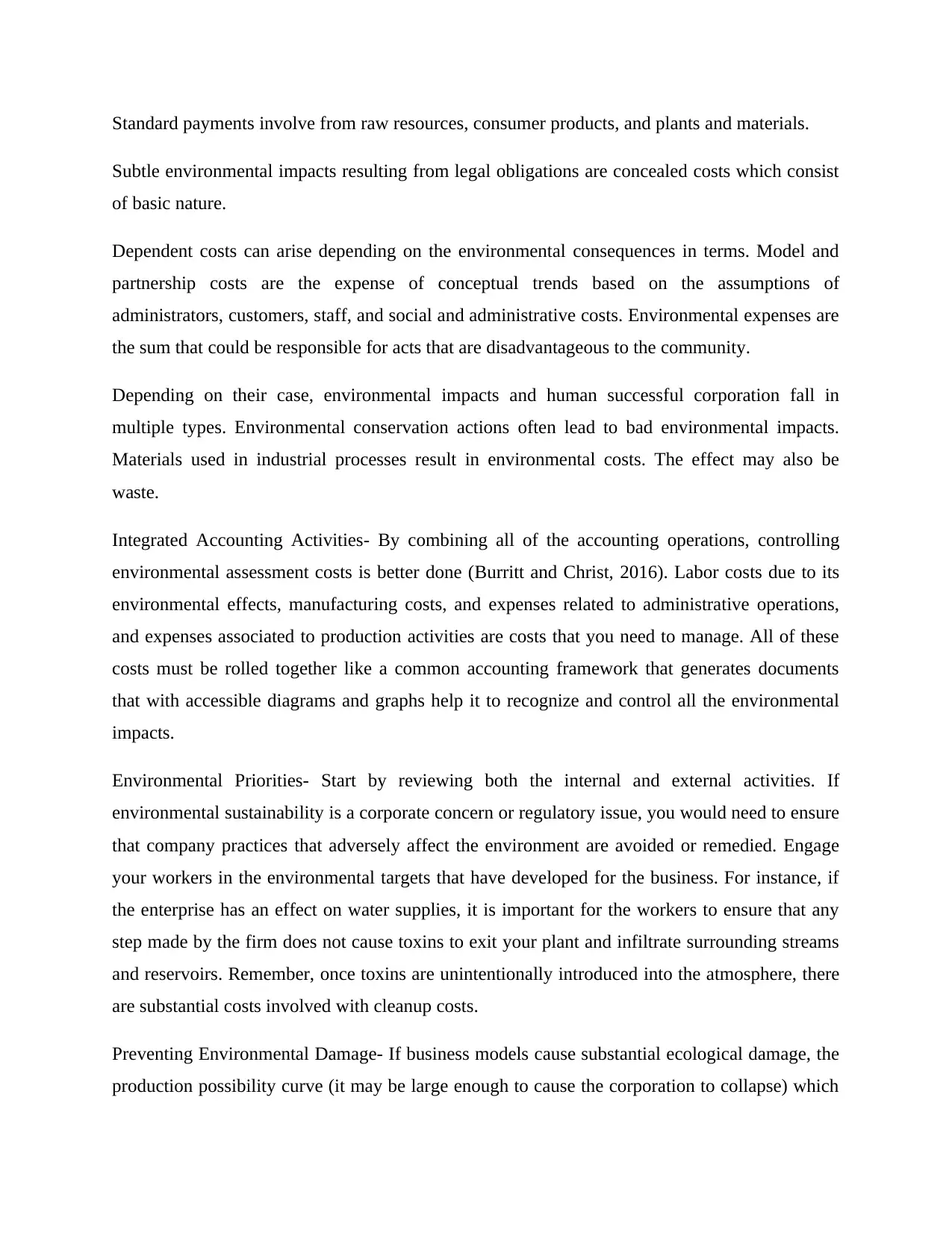
Standard payments involve from raw resources, consumer products, and plants and materials.
Subtle environmental impacts resulting from legal obligations are concealed costs which consist
of basic nature.
Dependent costs can arise depending on the environmental consequences in terms. Model and
partnership costs are the expense of conceptual trends based on the assumptions of
administrators, customers, staff, and social and administrative costs. Environmental expenses are
the sum that could be responsible for acts that are disadvantageous to the community.
Depending on their case, environmental impacts and human successful corporation fall in
multiple types. Environmental conservation actions often lead to bad environmental impacts.
Materials used in industrial processes result in environmental costs. The effect may also be
waste.
Integrated Accounting Activities- By combining all of the accounting operations, controlling
environmental assessment costs is better done (Burritt and Christ, 2016). Labor costs due to its
environmental effects, manufacturing costs, and expenses related to administrative operations,
and expenses associated to production activities are costs that you need to manage. All of these
costs must be rolled together like a common accounting framework that generates documents
that with accessible diagrams and graphs help it to recognize and control all the environmental
impacts.
Environmental Priorities- Start by reviewing both the internal and external activities. If
environmental sustainability is a corporate concern or regulatory issue, you would need to ensure
that company practices that adversely affect the environment are avoided or remedied. Engage
your workers in the environmental targets that have developed for the business. For instance, if
the enterprise has an effect on water supplies, it is important for the workers to ensure that any
step made by the firm does not cause toxins to exit your plant and infiltrate surrounding streams
and reservoirs. Remember, once toxins are unintentionally introduced into the atmosphere, there
are substantial costs involved with cleanup costs.
Preventing Environmental Damage- If business models cause substantial ecological damage, the
production possibility curve (it may be large enough to cause the corporation to collapse) which
Subtle environmental impacts resulting from legal obligations are concealed costs which consist
of basic nature.
Dependent costs can arise depending on the environmental consequences in terms. Model and
partnership costs are the expense of conceptual trends based on the assumptions of
administrators, customers, staff, and social and administrative costs. Environmental expenses are
the sum that could be responsible for acts that are disadvantageous to the community.
Depending on their case, environmental impacts and human successful corporation fall in
multiple types. Environmental conservation actions often lead to bad environmental impacts.
Materials used in industrial processes result in environmental costs. The effect may also be
waste.
Integrated Accounting Activities- By combining all of the accounting operations, controlling
environmental assessment costs is better done (Burritt and Christ, 2016). Labor costs due to its
environmental effects, manufacturing costs, and expenses related to administrative operations,
and expenses associated to production activities are costs that you need to manage. All of these
costs must be rolled together like a common accounting framework that generates documents
that with accessible diagrams and graphs help it to recognize and control all the environmental
impacts.
Environmental Priorities- Start by reviewing both the internal and external activities. If
environmental sustainability is a corporate concern or regulatory issue, you would need to ensure
that company practices that adversely affect the environment are avoided or remedied. Engage
your workers in the environmental targets that have developed for the business. For instance, if
the enterprise has an effect on water supplies, it is important for the workers to ensure that any
step made by the firm does not cause toxins to exit your plant and infiltrate surrounding streams
and reservoirs. Remember, once toxins are unintentionally introduced into the atmosphere, there
are substantial costs involved with cleanup costs.
Preventing Environmental Damage- If business models cause substantial ecological damage, the
production possibility curve (it may be large enough to cause the corporation to collapse) which
Paraphrase This Document
Need a fresh take? Get an instant paraphrase of this document with our AI Paraphraser
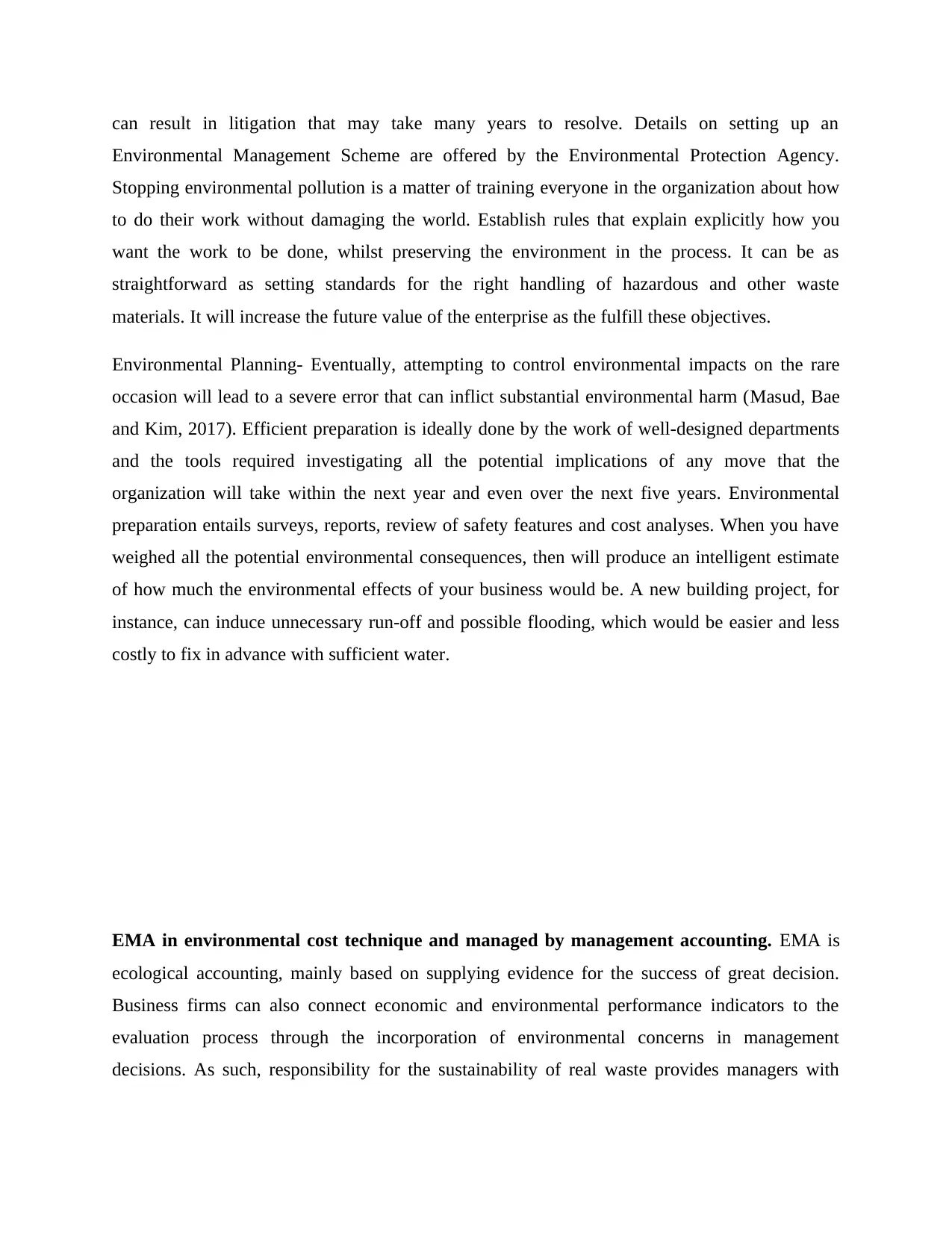
can result in litigation that may take many years to resolve. Details on setting up an
Environmental Management Scheme are offered by the Environmental Protection Agency.
Stopping environmental pollution is a matter of training everyone in the organization about how
to do their work without damaging the world. Establish rules that explain explicitly how you
want the work to be done, whilst preserving the environment in the process. It can be as
straightforward as setting standards for the right handling of hazardous and other waste
materials. It will increase the future value of the enterprise as the fulfill these objectives.
Environmental Planning- Eventually, attempting to control environmental impacts on the rare
occasion will lead to a severe error that can inflict substantial environmental harm (Masud, Bae
and Kim, 2017). Efficient preparation is ideally done by the work of well-designed departments
and the tools required investigating all the potential implications of any move that the
organization will take within the next year and even over the next five years. Environmental
preparation entails surveys, reports, review of safety features and cost analyses. When you have
weighed all the potential environmental consequences, then will produce an intelligent estimate
of how much the environmental effects of your business would be. A new building project, for
instance, can induce unnecessary run-off and possible flooding, which would be easier and less
costly to fix in advance with sufficient water.
EMA in environmental cost technique and managed by management accounting. EMA is
ecological accounting, mainly based on supplying evidence for the success of great decision.
Business firms can also connect economic and environmental performance indicators to the
evaluation process through the incorporation of environmental concerns in management
decisions. As such, responsibility for the sustainability of real waste provides managers with
Environmental Management Scheme are offered by the Environmental Protection Agency.
Stopping environmental pollution is a matter of training everyone in the organization about how
to do their work without damaging the world. Establish rules that explain explicitly how you
want the work to be done, whilst preserving the environment in the process. It can be as
straightforward as setting standards for the right handling of hazardous and other waste
materials. It will increase the future value of the enterprise as the fulfill these objectives.
Environmental Planning- Eventually, attempting to control environmental impacts on the rare
occasion will lead to a severe error that can inflict substantial environmental harm (Masud, Bae
and Kim, 2017). Efficient preparation is ideally done by the work of well-designed departments
and the tools required investigating all the potential implications of any move that the
organization will take within the next year and even over the next five years. Environmental
preparation entails surveys, reports, review of safety features and cost analyses. When you have
weighed all the potential environmental consequences, then will produce an intelligent estimate
of how much the environmental effects of your business would be. A new building project, for
instance, can induce unnecessary run-off and possible flooding, which would be easier and less
costly to fix in advance with sufficient water.
EMA in environmental cost technique and managed by management accounting. EMA is
ecological accounting, mainly based on supplying evidence for the success of great decision.
Business firms can also connect economic and environmental performance indicators to the
evaluation process through the incorporation of environmental concerns in management
decisions. As such, responsibility for the sustainability of real waste provides managers with
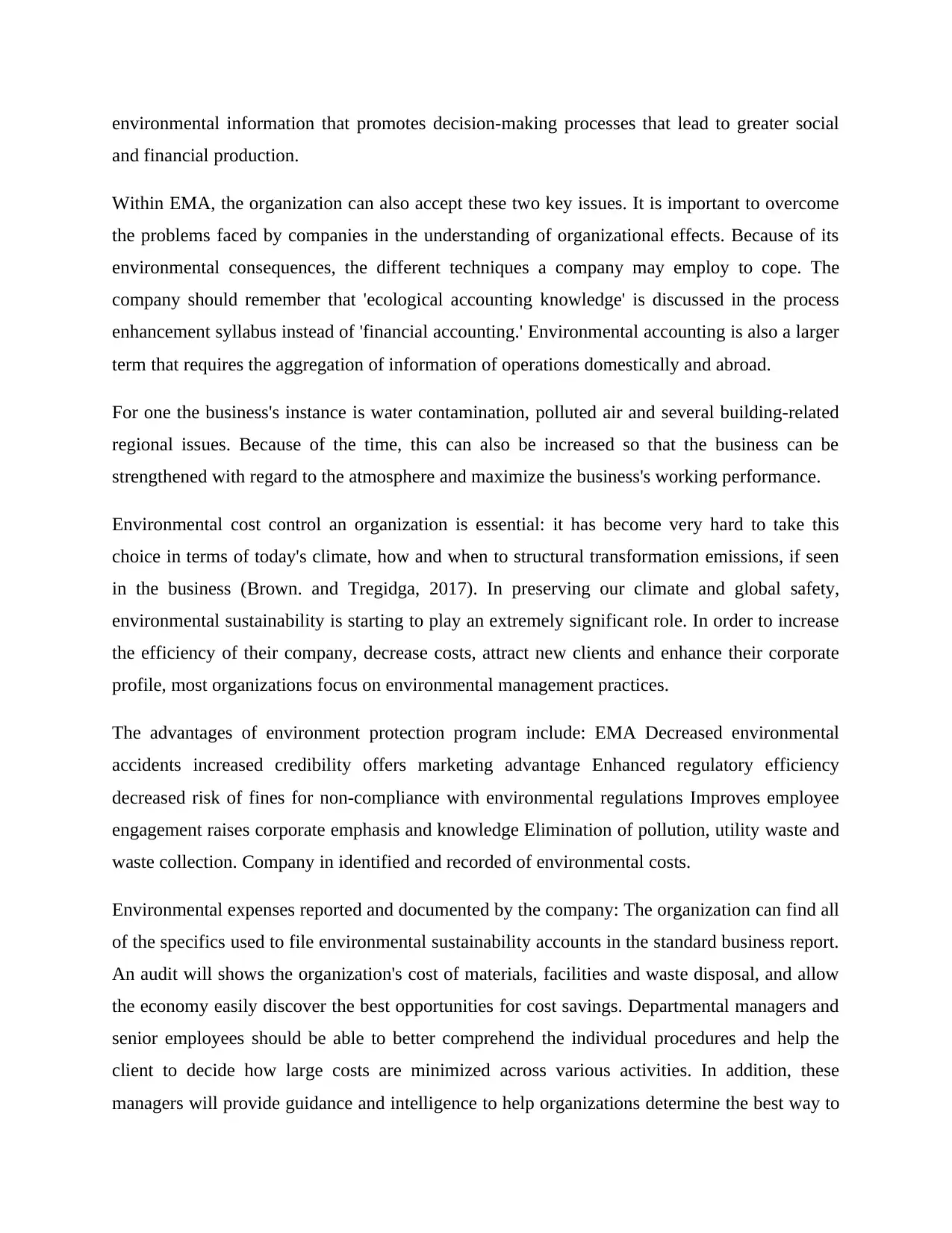
environmental information that promotes decision-making processes that lead to greater social
and financial production.
Within EMA, the organization can also accept these two key issues. It is important to overcome
the problems faced by companies in the understanding of organizational effects. Because of its
environmental consequences, the different techniques a company may employ to cope. The
company should remember that 'ecological accounting knowledge' is discussed in the process
enhancement syllabus instead of 'financial accounting.' Environmental accounting is also a larger
term that requires the aggregation of information of operations domestically and abroad.
For one the business's instance is water contamination, polluted air and several building-related
regional issues. Because of the time, this can also be increased so that the business can be
strengthened with regard to the atmosphere and maximize the business's working performance.
Environmental cost control an organization is essential: it has become very hard to take this
choice in terms of today's climate, how and when to structural transformation emissions, if seen
in the business (Brown. and Tregidga, 2017). In preserving our climate and global safety,
environmental sustainability is starting to play an extremely significant role. In order to increase
the efficiency of their company, decrease costs, attract new clients and enhance their corporate
profile, most organizations focus on environmental management practices.
The advantages of environment protection program include: EMA Decreased environmental
accidents increased credibility offers marketing advantage Enhanced regulatory efficiency
decreased risk of fines for non-compliance with environmental regulations Improves employee
engagement raises corporate emphasis and knowledge Elimination of pollution, utility waste and
waste collection. Company in identified and recorded of environmental costs.
Environmental expenses reported and documented by the company: The organization can find all
of the specifics used to file environmental sustainability accounts in the standard business report.
An audit will shows the organization's cost of materials, facilities and waste disposal, and allow
the economy easily discover the best opportunities for cost savings. Departmental managers and
senior employees should be able to better comprehend the individual procedures and help the
client to decide how large costs are minimized across various activities. In addition, these
managers will provide guidance and intelligence to help organizations determine the best way to
and financial production.
Within EMA, the organization can also accept these two key issues. It is important to overcome
the problems faced by companies in the understanding of organizational effects. Because of its
environmental consequences, the different techniques a company may employ to cope. The
company should remember that 'ecological accounting knowledge' is discussed in the process
enhancement syllabus instead of 'financial accounting.' Environmental accounting is also a larger
term that requires the aggregation of information of operations domestically and abroad.
For one the business's instance is water contamination, polluted air and several building-related
regional issues. Because of the time, this can also be increased so that the business can be
strengthened with regard to the atmosphere and maximize the business's working performance.
Environmental cost control an organization is essential: it has become very hard to take this
choice in terms of today's climate, how and when to structural transformation emissions, if seen
in the business (Brown. and Tregidga, 2017). In preserving our climate and global safety,
environmental sustainability is starting to play an extremely significant role. In order to increase
the efficiency of their company, decrease costs, attract new clients and enhance their corporate
profile, most organizations focus on environmental management practices.
The advantages of environment protection program include: EMA Decreased environmental
accidents increased credibility offers marketing advantage Enhanced regulatory efficiency
decreased risk of fines for non-compliance with environmental regulations Improves employee
engagement raises corporate emphasis and knowledge Elimination of pollution, utility waste and
waste collection. Company in identified and recorded of environmental costs.
Environmental expenses reported and documented by the company: The organization can find all
of the specifics used to file environmental sustainability accounts in the standard business report.
An audit will shows the organization's cost of materials, facilities and waste disposal, and allow
the economy easily discover the best opportunities for cost savings. Departmental managers and
senior employees should be able to better comprehend the individual procedures and help the
client to decide how large costs are minimized across various activities. In addition, these
managers will provide guidance and intelligence to help organizations determine the best way to
⊘ This is a preview!⊘
Do you want full access?
Subscribe today to unlock all pages.

Trusted by 1+ million students worldwide
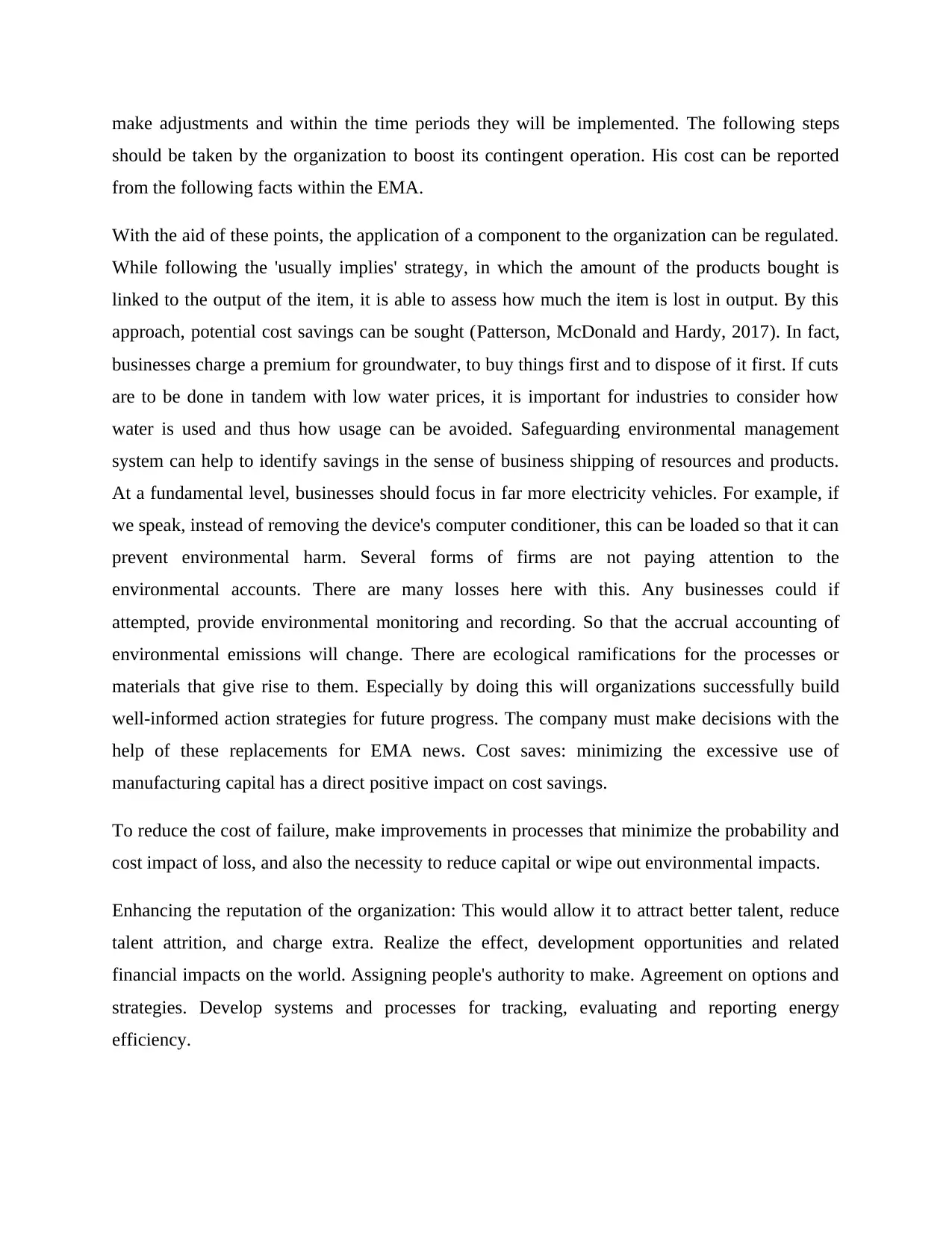
make adjustments and within the time periods they will be implemented. The following steps
should be taken by the organization to boost its contingent operation. His cost can be reported
from the following facts within the EMA.
With the aid of these points, the application of a component to the organization can be regulated.
While following the 'usually implies' strategy, in which the amount of the products bought is
linked to the output of the item, it is able to assess how much the item is lost in output. By this
approach, potential cost savings can be sought (Patterson, McDonald and Hardy, 2017). In fact,
businesses charge a premium for groundwater, to buy things first and to dispose of it first. If cuts
are to be done in tandem with low water prices, it is important for industries to consider how
water is used and thus how usage can be avoided. Safeguarding environmental management
system can help to identify savings in the sense of business shipping of resources and products.
At a fundamental level, businesses should focus in far more electricity vehicles. For example, if
we speak, instead of removing the device's computer conditioner, this can be loaded so that it can
prevent environmental harm. Several forms of firms are not paying attention to the
environmental accounts. There are many losses here with this. Any businesses could if
attempted, provide environmental monitoring and recording. So that the accrual accounting of
environmental emissions will change. There are ecological ramifications for the processes or
materials that give rise to them. Especially by doing this will organizations successfully build
well-informed action strategies for future progress. The company must make decisions with the
help of these replacements for EMA news. Cost saves: minimizing the excessive use of
manufacturing capital has a direct positive impact on cost savings.
To reduce the cost of failure, make improvements in processes that minimize the probability and
cost impact of loss, and also the necessity to reduce capital or wipe out environmental impacts.
Enhancing the reputation of the organization: This would allow it to attract better talent, reduce
talent attrition, and charge extra. Realize the effect, development opportunities and related
financial impacts on the world. Assigning people's authority to make. Agreement on options and
strategies. Develop systems and processes for tracking, evaluating and reporting energy
efficiency.
should be taken by the organization to boost its contingent operation. His cost can be reported
from the following facts within the EMA.
With the aid of these points, the application of a component to the organization can be regulated.
While following the 'usually implies' strategy, in which the amount of the products bought is
linked to the output of the item, it is able to assess how much the item is lost in output. By this
approach, potential cost savings can be sought (Patterson, McDonald and Hardy, 2017). In fact,
businesses charge a premium for groundwater, to buy things first and to dispose of it first. If cuts
are to be done in tandem with low water prices, it is important for industries to consider how
water is used and thus how usage can be avoided. Safeguarding environmental management
system can help to identify savings in the sense of business shipping of resources and products.
At a fundamental level, businesses should focus in far more electricity vehicles. For example, if
we speak, instead of removing the device's computer conditioner, this can be loaded so that it can
prevent environmental harm. Several forms of firms are not paying attention to the
environmental accounts. There are many losses here with this. Any businesses could if
attempted, provide environmental monitoring and recording. So that the accrual accounting of
environmental emissions will change. There are ecological ramifications for the processes or
materials that give rise to them. Especially by doing this will organizations successfully build
well-informed action strategies for future progress. The company must make decisions with the
help of these replacements for EMA news. Cost saves: minimizing the excessive use of
manufacturing capital has a direct positive impact on cost savings.
To reduce the cost of failure, make improvements in processes that minimize the probability and
cost impact of loss, and also the necessity to reduce capital or wipe out environmental impacts.
Enhancing the reputation of the organization: This would allow it to attract better talent, reduce
talent attrition, and charge extra. Realize the effect, development opportunities and related
financial impacts on the world. Assigning people's authority to make. Agreement on options and
strategies. Develop systems and processes for tracking, evaluating and reporting energy
efficiency.
Paraphrase This Document
Need a fresh take? Get an instant paraphrase of this document with our AI Paraphraser
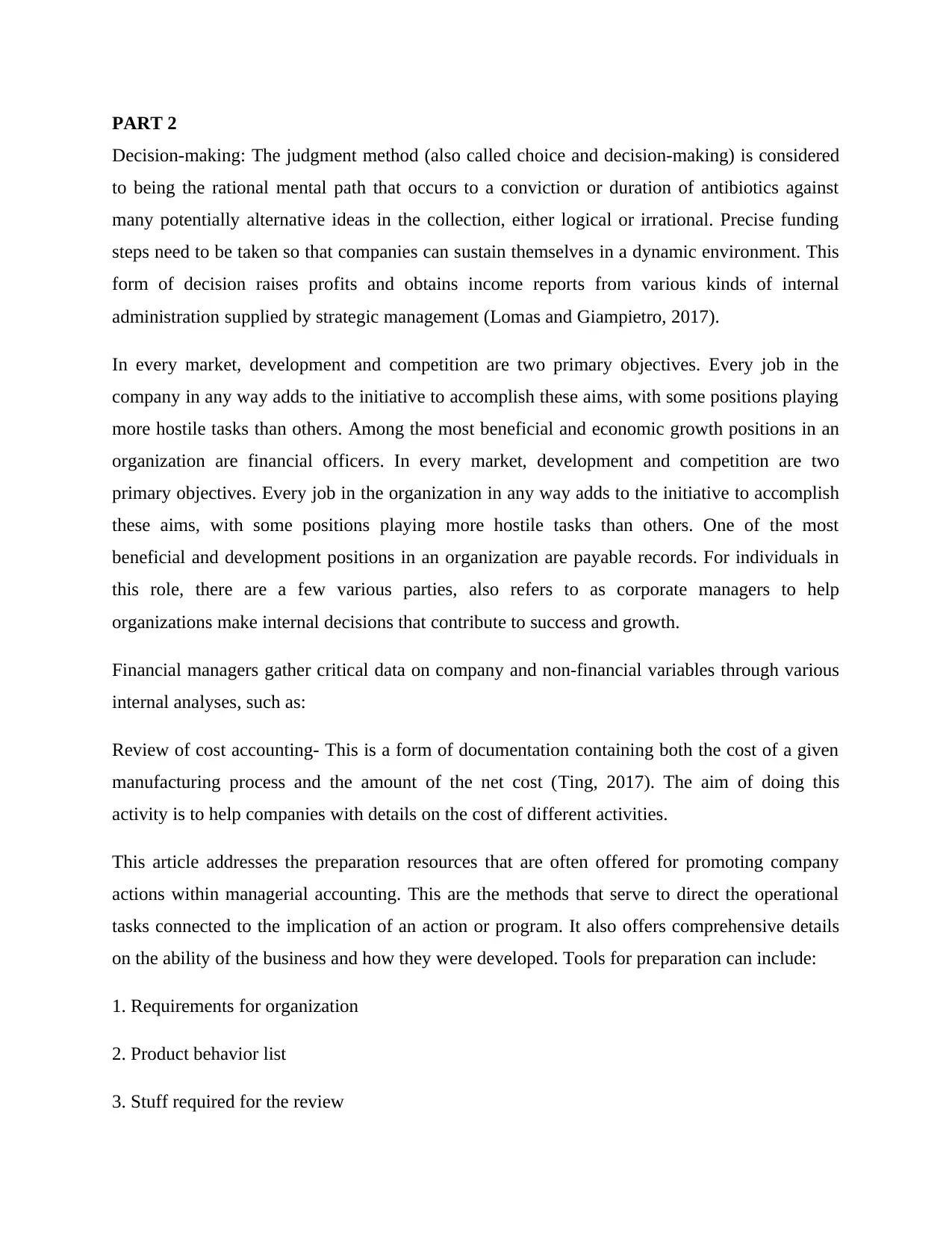
PART 2
Decision-making: The judgment method (also called choice and decision-making) is considered
to being the rational mental path that occurs to a conviction or duration of antibiotics against
many potentially alternative ideas in the collection, either logical or irrational. Precise funding
steps need to be taken so that companies can sustain themselves in a dynamic environment. This
form of decision raises profits and obtains income reports from various kinds of internal
administration supplied by strategic management (Lomas and Giampietro, 2017).
In every market, development and competition are two primary objectives. Every job in the
company in any way adds to the initiative to accomplish these aims, with some positions playing
more hostile tasks than others. Among the most beneficial and economic growth positions in an
organization are financial officers. In every market, development and competition are two
primary objectives. Every job in the organization in any way adds to the initiative to accomplish
these aims, with some positions playing more hostile tasks than others. One of the most
beneficial and development positions in an organization are payable records. For individuals in
this role, there are a few various parties, also refers to as corporate managers to help
organizations make internal decisions that contribute to success and growth.
Financial managers gather critical data on company and non-financial variables through various
internal analyses, such as:
Review of cost accounting- This is a form of documentation containing both the cost of a given
manufacturing process and the amount of the net cost (Ting, 2017). The aim of doing this
activity is to help companies with details on the cost of different activities.
This article addresses the preparation resources that are often offered for promoting company
actions within managerial accounting. This are the methods that serve to direct the operational
tasks connected to the implication of an action or program. It also offers comprehensive details
on the ability of the business and how they were developed. Tools for preparation can include:
1. Requirements for organization
2. Product behavior list
3. Stuff required for the review
Decision-making: The judgment method (also called choice and decision-making) is considered
to being the rational mental path that occurs to a conviction or duration of antibiotics against
many potentially alternative ideas in the collection, either logical or irrational. Precise funding
steps need to be taken so that companies can sustain themselves in a dynamic environment. This
form of decision raises profits and obtains income reports from various kinds of internal
administration supplied by strategic management (Lomas and Giampietro, 2017).
In every market, development and competition are two primary objectives. Every job in the
company in any way adds to the initiative to accomplish these aims, with some positions playing
more hostile tasks than others. Among the most beneficial and economic growth positions in an
organization are financial officers. In every market, development and competition are two
primary objectives. Every job in the organization in any way adds to the initiative to accomplish
these aims, with some positions playing more hostile tasks than others. One of the most
beneficial and development positions in an organization are payable records. For individuals in
this role, there are a few various parties, also refers to as corporate managers to help
organizations make internal decisions that contribute to success and growth.
Financial managers gather critical data on company and non-financial variables through various
internal analyses, such as:
Review of cost accounting- This is a form of documentation containing both the cost of a given
manufacturing process and the amount of the net cost (Ting, 2017). The aim of doing this
activity is to help companies with details on the cost of different activities.
This article addresses the preparation resources that are often offered for promoting company
actions within managerial accounting. This are the methods that serve to direct the operational
tasks connected to the implication of an action or program. It also offers comprehensive details
on the ability of the business and how they were developed. Tools for preparation can include:
1. Requirements for organization
2. Product behavior list
3. Stuff required for the review
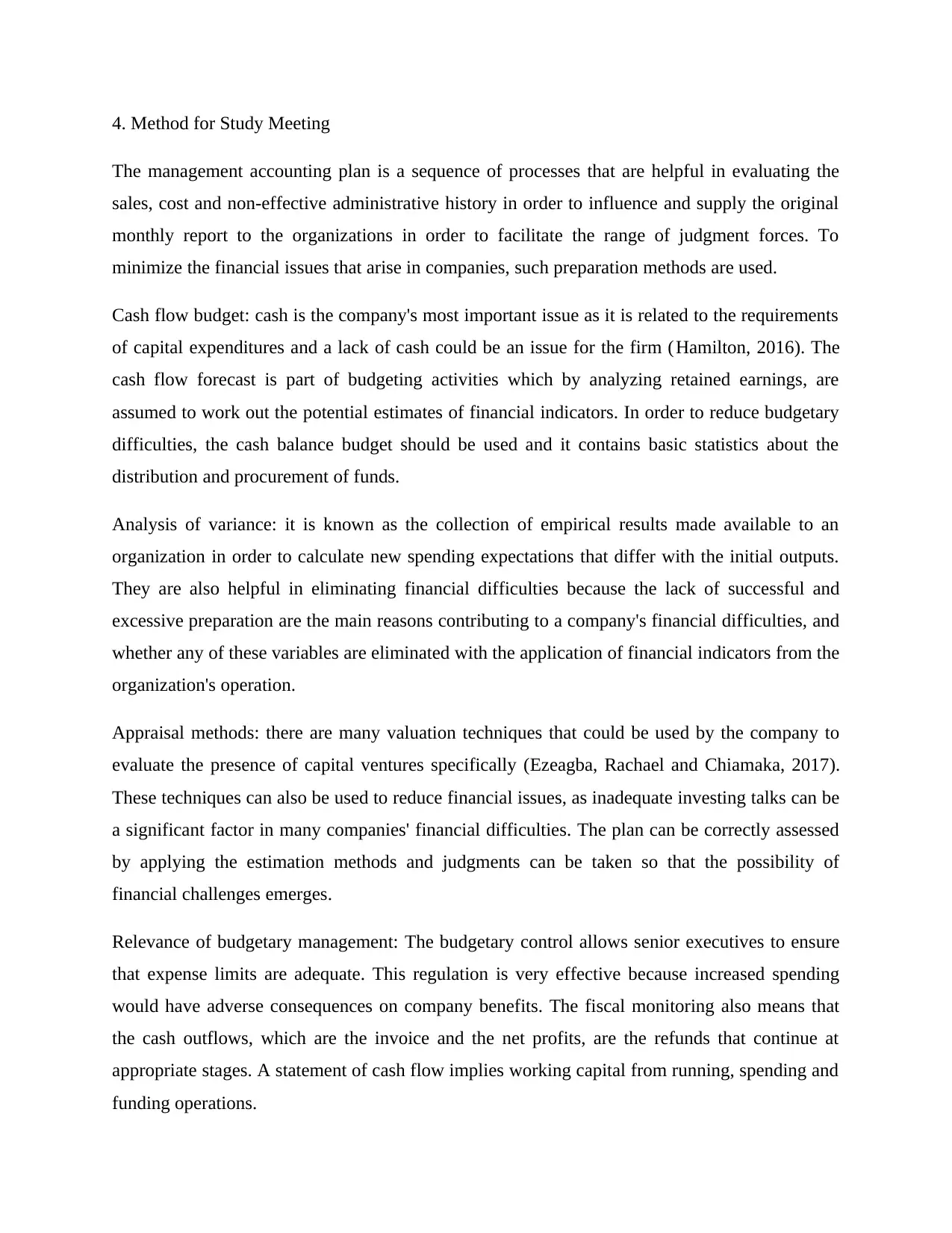
4. Method for Study Meeting
The management accounting plan is a sequence of processes that are helpful in evaluating the
sales, cost and non-effective administrative history in order to influence and supply the original
monthly report to the organizations in order to facilitate the range of judgment forces. To
minimize the financial issues that arise in companies, such preparation methods are used.
Cash flow budget: cash is the company's most important issue as it is related to the requirements
of capital expenditures and a lack of cash could be an issue for the firm (Hamilton, 2016). The
cash flow forecast is part of budgeting activities which by analyzing retained earnings, are
assumed to work out the potential estimates of financial indicators. In order to reduce budgetary
difficulties, the cash balance budget should be used and it contains basic statistics about the
distribution and procurement of funds.
Analysis of variance: it is known as the collection of empirical results made available to an
organization in order to calculate new spending expectations that differ with the initial outputs.
They are also helpful in eliminating financial difficulties because the lack of successful and
excessive preparation are the main reasons contributing to a company's financial difficulties, and
whether any of these variables are eliminated with the application of financial indicators from the
organization's operation.
Appraisal methods: there are many valuation techniques that could be used by the company to
evaluate the presence of capital ventures specifically (Ezeagba, Rachael and Chiamaka, 2017).
These techniques can also be used to reduce financial issues, as inadequate investing talks can be
a significant factor in many companies' financial difficulties. The plan can be correctly assessed
by applying the estimation methods and judgments can be taken so that the possibility of
financial challenges emerges.
Relevance of budgetary management: The budgetary control allows senior executives to ensure
that expense limits are adequate. This regulation is very effective because increased spending
would have adverse consequences on company benefits. The fiscal monitoring also means that
the cash outflows, which are the invoice and the net profits, are the refunds that continue at
appropriate stages. A statement of cash flow implies working capital from running, spending and
funding operations.
The management accounting plan is a sequence of processes that are helpful in evaluating the
sales, cost and non-effective administrative history in order to influence and supply the original
monthly report to the organizations in order to facilitate the range of judgment forces. To
minimize the financial issues that arise in companies, such preparation methods are used.
Cash flow budget: cash is the company's most important issue as it is related to the requirements
of capital expenditures and a lack of cash could be an issue for the firm (Hamilton, 2016). The
cash flow forecast is part of budgeting activities which by analyzing retained earnings, are
assumed to work out the potential estimates of financial indicators. In order to reduce budgetary
difficulties, the cash balance budget should be used and it contains basic statistics about the
distribution and procurement of funds.
Analysis of variance: it is known as the collection of empirical results made available to an
organization in order to calculate new spending expectations that differ with the initial outputs.
They are also helpful in eliminating financial difficulties because the lack of successful and
excessive preparation are the main reasons contributing to a company's financial difficulties, and
whether any of these variables are eliminated with the application of financial indicators from the
organization's operation.
Appraisal methods: there are many valuation techniques that could be used by the company to
evaluate the presence of capital ventures specifically (Ezeagba, Rachael and Chiamaka, 2017).
These techniques can also be used to reduce financial issues, as inadequate investing talks can be
a significant factor in many companies' financial difficulties. The plan can be correctly assessed
by applying the estimation methods and judgments can be taken so that the possibility of
financial challenges emerges.
Relevance of budgetary management: The budgetary control allows senior executives to ensure
that expense limits are adequate. This regulation is very effective because increased spending
would have adverse consequences on company benefits. The fiscal monitoring also means that
the cash outflows, which are the invoice and the net profits, are the refunds that continue at
appropriate stages. A statement of cash flow implies working capital from running, spending and
funding operations.
⊘ This is a preview!⊘
Do you want full access?
Subscribe today to unlock all pages.

Trusted by 1+ million students worldwide

To use the predictive models, this is one of the fiscal control means significance that the
prediction models should be used together with this. There are divisions that work hard to
determine the right outcomes for the future. These offices include the division of accounting, the
analytical division, and the unit of administration.
Successful use of the resources of the organization- A business can only successfully use its
capital if someone prevents the abuse of the firm's profits (Ofoegbu and Megbuluba, 2016). If the
strategy of budgetary management is used in industry, no action is taken until the budget is made
at that point. The corporation's responsible workers will be liable for this action.
Relevance of the KPI in enhancing financial performance: The key purpose of the KPI is to
manage success in meeting the strategic targets usually associated with a strategic map. The
primary and key move that KPI is looking at is to formulate a concise and clear understood
strategic plan that can be used to find out the corporation's priorities. KPIs need more productive
material and this will only be accomplished if you have not only clarified what you estimate, but
also why you estimate it. KPI's primary aim is to get something realistic about what the
enterprise is planning to do, and it would also be easy to learn about the corporate model of the
corporation only by using the KPIs.
Financial sustainability of enterprises: From a financial perspective, financial market can be
defined as the potential to advance, expand and cooperate with the employee company, along
with brief & medium stability. An organization that has reached financial viability is one that
offers a commodity or administration in a scope that not only hides its costs, but also makes
some benefit. There are just a few points related to keeping business viable:
1. Financial perseverance: It is meant to run under productivity, since this is what seems to be the
real financial survival. A strong company is financial sustainability (Yang and Feng, 2017).
2. Resilience to regulation: Investing in enforcement. It is very pricey, but it is important to
invest in good relevant and investment support. Constructing a new stability framework for the
enterprise as one advance that prevents one from adjusting expensively to fix the vulnerabilities
which were identified as described.
prediction models should be used together with this. There are divisions that work hard to
determine the right outcomes for the future. These offices include the division of accounting, the
analytical division, and the unit of administration.
Successful use of the resources of the organization- A business can only successfully use its
capital if someone prevents the abuse of the firm's profits (Ofoegbu and Megbuluba, 2016). If the
strategy of budgetary management is used in industry, no action is taken until the budget is made
at that point. The corporation's responsible workers will be liable for this action.
Relevance of the KPI in enhancing financial performance: The key purpose of the KPI is to
manage success in meeting the strategic targets usually associated with a strategic map. The
primary and key move that KPI is looking at is to formulate a concise and clear understood
strategic plan that can be used to find out the corporation's priorities. KPIs need more productive
material and this will only be accomplished if you have not only clarified what you estimate, but
also why you estimate it. KPI's primary aim is to get something realistic about what the
enterprise is planning to do, and it would also be easy to learn about the corporate model of the
corporation only by using the KPIs.
Financial sustainability of enterprises: From a financial perspective, financial market can be
defined as the potential to advance, expand and cooperate with the employee company, along
with brief & medium stability. An organization that has reached financial viability is one that
offers a commodity or administration in a scope that not only hides its costs, but also makes
some benefit. There are just a few points related to keeping business viable:
1. Financial perseverance: It is meant to run under productivity, since this is what seems to be the
real financial survival. A strong company is financial sustainability (Yang and Feng, 2017).
2. Resilience to regulation: Investing in enforcement. It is very pricey, but it is important to
invest in good relevant and investment support. Constructing a new stability framework for the
enterprise as one advance that prevents one from adjusting expensively to fix the vulnerabilities
which were identified as described.
Paraphrase This Document
Need a fresh take? Get an instant paraphrase of this document with our AI Paraphraser
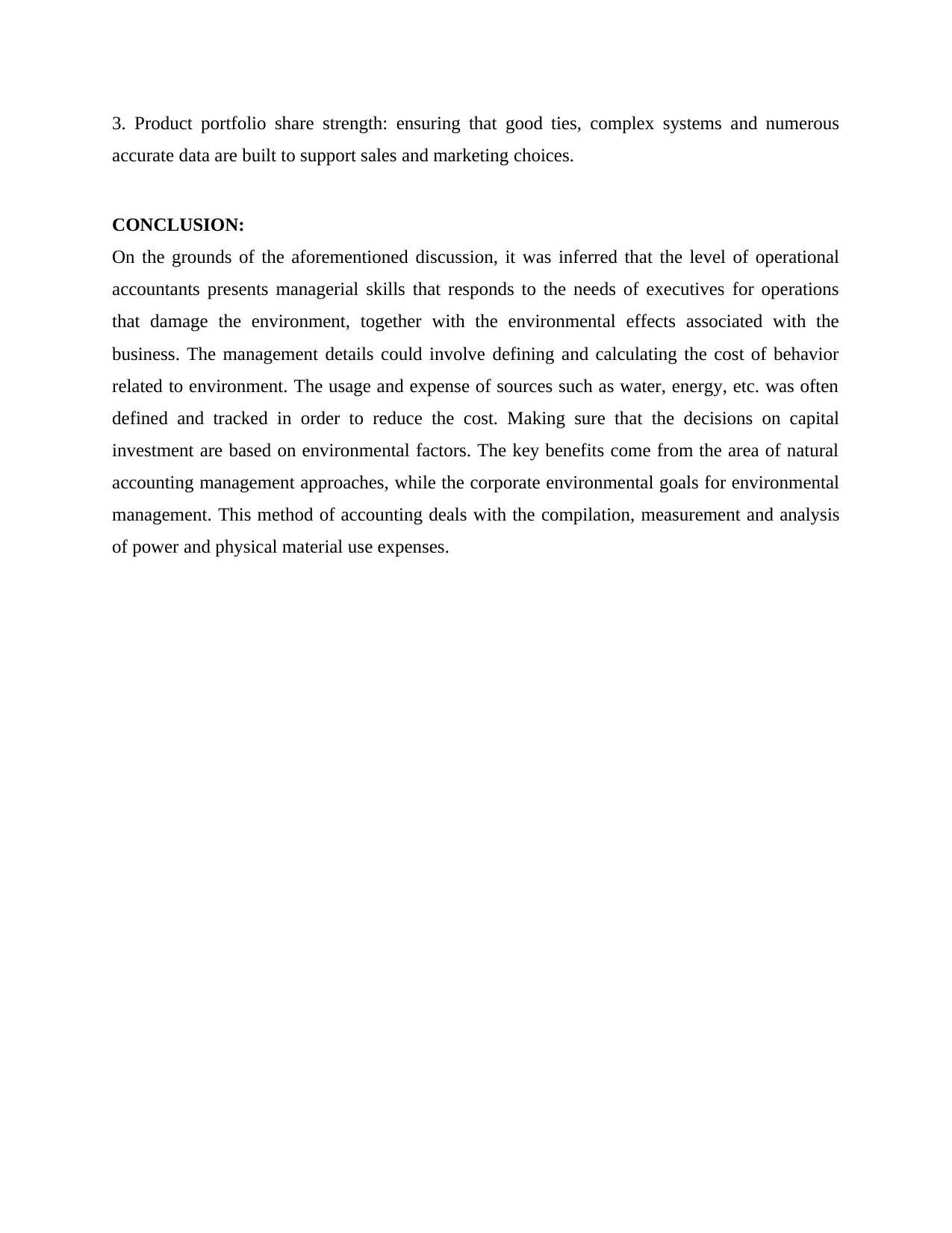
3. Product portfolio share strength: ensuring that good ties, complex systems and numerous
accurate data are built to support sales and marketing choices.
CONCLUSION:
On the grounds of the aforementioned discussion, it was inferred that the level of operational
accountants presents managerial skills that responds to the needs of executives for operations
that damage the environment, together with the environmental effects associated with the
business. The management details could involve defining and calculating the cost of behavior
related to environment. The usage and expense of sources such as water, energy, etc. was often
defined and tracked in order to reduce the cost. Making sure that the decisions on capital
investment are based on environmental factors. The key benefits come from the area of natural
accounting management approaches, while the corporate environmental goals for environmental
management. This method of accounting deals with the compilation, measurement and analysis
of power and physical material use expenses.
accurate data are built to support sales and marketing choices.
CONCLUSION:
On the grounds of the aforementioned discussion, it was inferred that the level of operational
accountants presents managerial skills that responds to the needs of executives for operations
that damage the environment, together with the environmental effects associated with the
business. The management details could involve defining and calculating the cost of behavior
related to environment. The usage and expense of sources such as water, energy, etc. was often
defined and tracked in order to reduce the cost. Making sure that the decisions on capital
investment are based on environmental factors. The key benefits come from the area of natural
accounting management approaches, while the corporate environmental goals for environmental
management. This method of accounting deals with the compilation, measurement and analysis
of power and physical material use expenses.
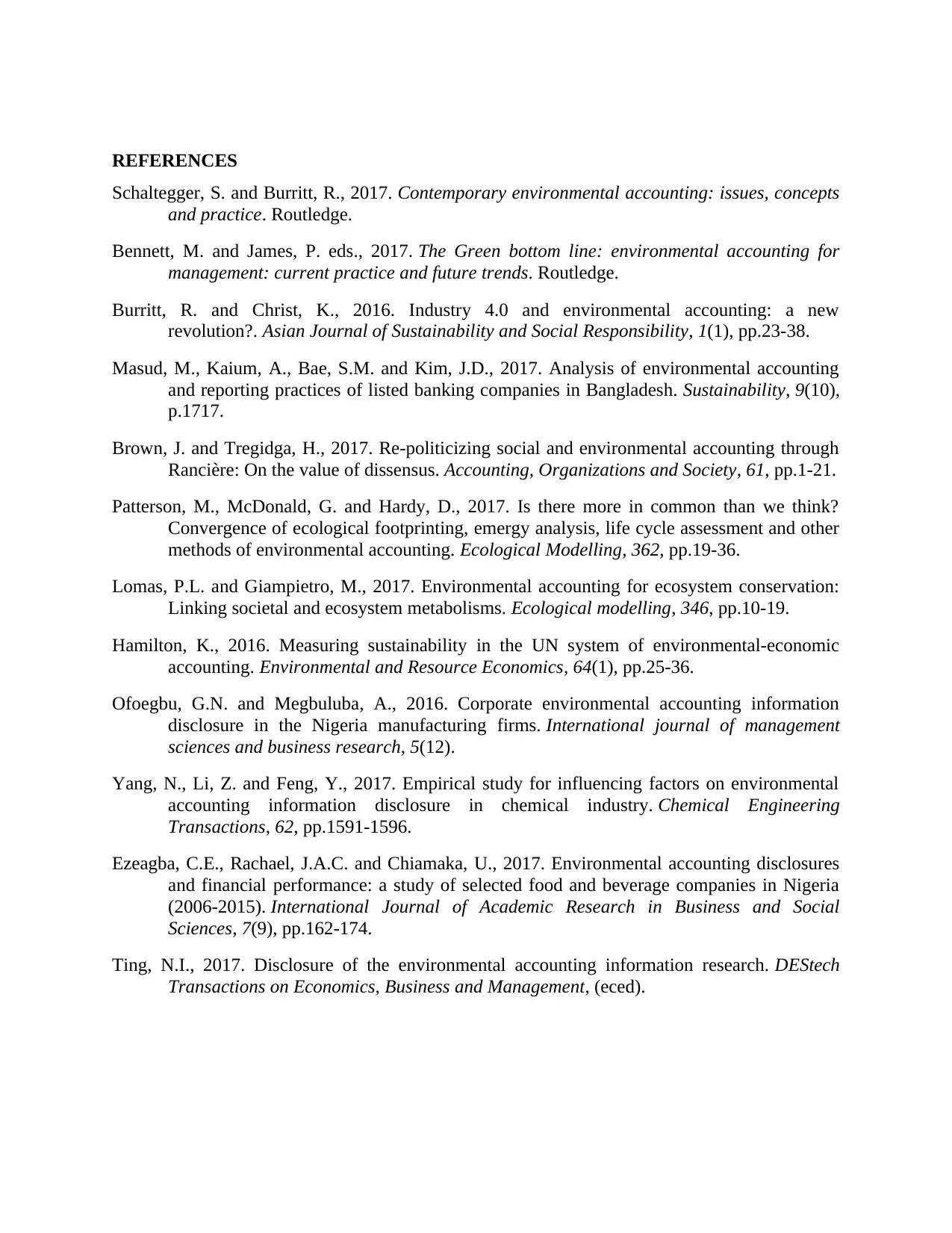
REFERENCES
Schaltegger, S. and Burritt, R., 2017. Contemporary environmental accounting: issues, concepts
and practice. Routledge.
Bennett, M. and James, P. eds., 2017. The Green bottom line: environmental accounting for
management: current practice and future trends. Routledge.
Burritt, R. and Christ, K., 2016. Industry 4.0 and environmental accounting: a new
revolution?. Asian Journal of Sustainability and Social Responsibility, 1(1), pp.23-38.
Masud, M., Kaium, A., Bae, S.M. and Kim, J.D., 2017. Analysis of environmental accounting
and reporting practices of listed banking companies in Bangladesh. Sustainability, 9(10),
p.1717.
Brown, J. and Tregidga, H., 2017. Re-politicizing social and environmental accounting through
Rancière: On the value of dissensus. Accounting, Organizations and Society, 61, pp.1-21.
Patterson, M., McDonald, G. and Hardy, D., 2017. Is there more in common than we think?
Convergence of ecological footprinting, emergy analysis, life cycle assessment and other
methods of environmental accounting. Ecological Modelling, 362, pp.19-36.
Lomas, P.L. and Giampietro, M., 2017. Environmental accounting for ecosystem conservation:
Linking societal and ecosystem metabolisms. Ecological modelling, 346, pp.10-19.
Hamilton, K., 2016. Measuring sustainability in the UN system of environmental-economic
accounting. Environmental and Resource Economics, 64(1), pp.25-36.
Ofoegbu, G.N. and Megbuluba, A., 2016. Corporate environmental accounting information
disclosure in the Nigeria manufacturing firms. International journal of management
sciences and business research, 5(12).
Yang, N., Li, Z. and Feng, Y., 2017. Empirical study for influencing factors on environmental
accounting information disclosure in chemical industry. Chemical Engineering
Transactions, 62, pp.1591-1596.
Ezeagba, C.E., Rachael, J.A.C. and Chiamaka, U., 2017. Environmental accounting disclosures
and financial performance: a study of selected food and beverage companies in Nigeria
(2006-2015). International Journal of Academic Research in Business and Social
Sciences, 7(9), pp.162-174.
Ting, N.I., 2017. Disclosure of the environmental accounting information research. DEStech
Transactions on Economics, Business and Management, (eced).
Schaltegger, S. and Burritt, R., 2017. Contemporary environmental accounting: issues, concepts
and practice. Routledge.
Bennett, M. and James, P. eds., 2017. The Green bottom line: environmental accounting for
management: current practice and future trends. Routledge.
Burritt, R. and Christ, K., 2016. Industry 4.0 and environmental accounting: a new
revolution?. Asian Journal of Sustainability and Social Responsibility, 1(1), pp.23-38.
Masud, M., Kaium, A., Bae, S.M. and Kim, J.D., 2017. Analysis of environmental accounting
and reporting practices of listed banking companies in Bangladesh. Sustainability, 9(10),
p.1717.
Brown, J. and Tregidga, H., 2017. Re-politicizing social and environmental accounting through
Rancière: On the value of dissensus. Accounting, Organizations and Society, 61, pp.1-21.
Patterson, M., McDonald, G. and Hardy, D., 2017. Is there more in common than we think?
Convergence of ecological footprinting, emergy analysis, life cycle assessment and other
methods of environmental accounting. Ecological Modelling, 362, pp.19-36.
Lomas, P.L. and Giampietro, M., 2017. Environmental accounting for ecosystem conservation:
Linking societal and ecosystem metabolisms. Ecological modelling, 346, pp.10-19.
Hamilton, K., 2016. Measuring sustainability in the UN system of environmental-economic
accounting. Environmental and Resource Economics, 64(1), pp.25-36.
Ofoegbu, G.N. and Megbuluba, A., 2016. Corporate environmental accounting information
disclosure in the Nigeria manufacturing firms. International journal of management
sciences and business research, 5(12).
Yang, N., Li, Z. and Feng, Y., 2017. Empirical study for influencing factors on environmental
accounting information disclosure in chemical industry. Chemical Engineering
Transactions, 62, pp.1591-1596.
Ezeagba, C.E., Rachael, J.A.C. and Chiamaka, U., 2017. Environmental accounting disclosures
and financial performance: a study of selected food and beverage companies in Nigeria
(2006-2015). International Journal of Academic Research in Business and Social
Sciences, 7(9), pp.162-174.
Ting, N.I., 2017. Disclosure of the environmental accounting information research. DEStech
Transactions on Economics, Business and Management, (eced).
⊘ This is a preview!⊘
Do you want full access?
Subscribe today to unlock all pages.

Trusted by 1+ million students worldwide
1 out of 12
Related Documents
Your All-in-One AI-Powered Toolkit for Academic Success.
+13062052269
info@desklib.com
Available 24*7 on WhatsApp / Email
![[object Object]](/_next/static/media/star-bottom.7253800d.svg)
Unlock your academic potential
Copyright © 2020–2025 A2Z Services. All Rights Reserved. Developed and managed by ZUCOL.





